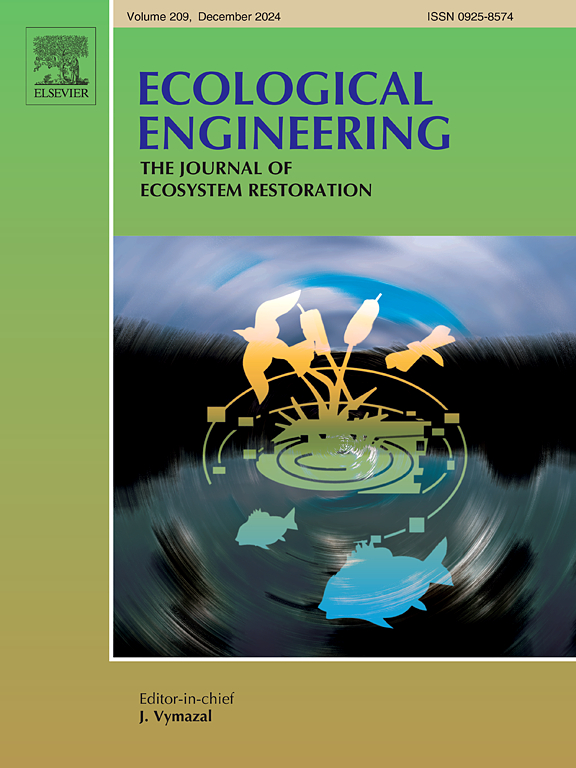喀斯特退化区人工植被恢复模式通过多营养生物共现网络复杂性调控土壤多功能性
IF 4.1
2区 环境科学与生态学
Q1 ECOLOGY
引用次数: 0
摘要
近年来,西南喀斯特地区退化植被的恢复工作取得了显著进展。然而,这种修复对土壤多功能性(SMF)和土壤多营养生物的影响在很大程度上尚未被探索。研究了西南喀斯特地区3种典型人工植被恢复模式(草、林、林-草)的SMF。利用高通量测序、形态鉴定和共生网络分析等方法研究了喀斯特土壤中多营养生物群落的特征。植被恢复模式显著影响土壤单一功能、土壤土壤肥力和土壤多营养生物多样性。所有土壤生物共现网络均以正相关关系为主,且林草模式的网络复杂性高于林草模式。共现网络拓扑参数与土壤功能呈显著相关,而土壤多营养生物多样性与土壤功能无显著相关。结构方程模型表明,恢复模式、土壤pH值、土壤湿度、土壤多营养生物多样性和共发生网络复杂性共同解释了64%的土壤土壤土壤肥力变化。恢复模式不仅直接影响SMF (p <;0.01),但也通过改变土壤pH值和共现网络的复杂性间接影响SMF。这些发现有助于更好地理解喀斯特地区植被恢复对土壤功能影响的机制,特别是从土壤多营养生物的角度。本文章由计算机程序翻译,如有差异,请以英文原文为准。
Artificial vegetation restoration patterns regulated soil multifunctionality via co-occurrence network complexity of multitrophic organism in degraded karst region
Significant advancements have been achieved in recent years in the restoration of degraded vegetation in the karst regions of Southwest China. However, the effects of this restoration on soil multifunctionality (SMF) and soil multi-trophic organism remained largely unexplored. This study investigated SMF of three typical artificial vegetation restoration patterns (grass, forest, and forest-grass) in the Southwest karst region. High-throughput sequencing, morphological identification, and co-occurrence network analysis were utilized to examine the characteristics of multi-trophic organism communities in karst soil. Vegetation restoration patterns significantly affected single soil functions, SMF, and the biodiversity of soil multi-trophic organism. All co-occurrence networks of soil organism were predominantly positive relationships, with network in forest-grass pattern exhibiting greater complexity than that of forest and grass patterns. The topological parameters of the co-occurrence network showed a significant correlation with soil functions, while soil multi-trophic organism diversity did not. Structural equation models revealed that the restoration pattern, soil pH, soil moisture, soil multi-trophic organism diversity, and co-occurrence network complexity collectively explained 64 % of the SMF variation. The restoration pattern not only directly influenced SMF (p < 0.01) but also indirectly affected SMF by altering soil pH and the complexity of the co-occurrence network. These insights provide a better comprehension of the mechanisms underlying vegetation restoration effects on soil functions in karst regions, specifically from the perspective of soil multi-trophic organism.
求助全文
通过发布文献求助,成功后即可免费获取论文全文。
去求助
来源期刊

Ecological Engineering
环境科学-工程:环境
CiteScore
8.00
自引率
5.30%
发文量
293
审稿时长
57 days
期刊介绍:
Ecological engineering has been defined as the design of ecosystems for the mutual benefit of humans and nature. The journal is meant for ecologists who, because of their research interests or occupation, are involved in designing, monitoring, or restoring ecosystems, and can serve as a bridge between ecologists and engineers.
Specific topics covered in the journal include: habitat reconstruction; ecotechnology; synthetic ecology; bioengineering; restoration ecology; ecology conservation; ecosystem rehabilitation; stream and river restoration; reclamation ecology; non-renewable resource conservation. Descriptions of specific applications of ecological engineering are acceptable only when situated within context of adding novelty to current research and emphasizing ecosystem restoration. We do not accept purely descriptive reports on ecosystem structures (such as vegetation surveys), purely physical assessment of materials that can be used for ecological restoration, small-model studies carried out in the laboratory or greenhouse with artificial (waste)water or crop studies, or case studies on conventional wastewater treatment and eutrophication that do not offer an ecosystem restoration approach within the paper.
 求助内容:
求助内容: 应助结果提醒方式:
应助结果提醒方式:


